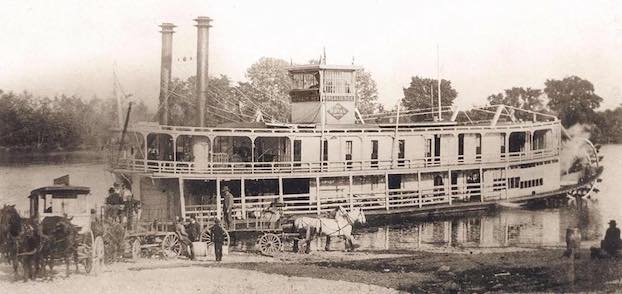The Informer: Borealis Rex reigned on the Calcasieu for nearly 30 years
Published 4:52 am Saturday, January 25, 2025

- A flier promoting the Borealis Rex, circa 1919, said the steamboat could hold 250 passengers and 200 tons of freight. The roof of the pilot house in this photo — shown after the boat was raised and repaired following its 1918 sinking — is slightly different than the original design. (Special to the American Press)
Editor’s Note: This year’s Informer column will feature a treasure trove of historic photos from the American Press Archives and their significance to Southwest Louisiana.
Long before a highway system connected Lake Charles and Cameron — then known as Leesburg —the paddle-wheel steamboat Borealis Rex was a popular means of transport for commercial and social ventures along the Calcasieu River.
The Borealis Rex, also known as the “Northern King,” was a Mississippi River steamboat brought to Southwest Louisiana in 1905 by T.C. McCain, A.B. McCain and J.S. Thomson, each of whom purchased a one-third interest in a new business they named the Lake Charles and Cameron Transportation Co.
The trio purchased the steamboat for about $14,000.
The Rex was built in Still Water, Minn., in 1888 by D.W. Swain. He is also credited with naming the vessel, which had two decks stretching out ahead of a large rear paddle wheel. Above the second deck near the front were mounted its two smokestacks, and behind them stood its ornate pilot house with a 8-foot steering wheel.
The Rex was 22-feet wide and 121.5-feet long and its top speed was about 15 mph.
Week after week, year after year, the boat’s schedule remained the same, according to a 1993 American Press article. On Mondays, Wednesdays and Fridays it headed south from Lake Charles at 8:30 a.m. and arrived in Cameron at about noon. The next day on Tuesdays, Thursdays and Saturdays it made the return trip to Lake Charles.
On Sundays during the warm months the Rex made one-day round trip excursions to Big Lake and the Gulf of Mexico (ahem, Gulf of America).
“On these trips it often carried more than 100 paying passengers, a dance band and food and drinks,” according to the article.
It is said that when people heard the ship arriving, they stopped what they were doing and went over to visit and see what or who had arrived.
When the paddlewheel steamer ship wasn’t in use, she was docked at the foot of Pujo Street. (Last week, this column featured photos of the lake being filled to create land for the Lake Charles Civic Center. Part of the lake that was filled included the Rex’s wharf site).
On her journeys, the Rex carried mail, freight, groceries, bales of cotton, cattle, firewood and even Ford Model-Ts from the Huber Motor Company.
“Drummers, cattle and cotton buyers, priests, schoolteachers, and insurance salesmen were among her passengers as well as the circuit judges, lawyers, and staffers who made monthly trips from Lake Charles to conduct court in Cameron,” according to the late historian Nola Mae Ross, who was a frequent contributer to the American Press. “The Rex quickly became a lifeline between Lake Charles and Cameron, as well as other points along the way.”
Disaster strikes
The roughest weather the Rex ever faced was a hurricane that struck Southwest Louisiana on Aug. 6, 1918.
“Fortunately for the 40 passengers on board that day, the crew was able to pull ashore and get everyone off before the storm’s 100 mile-per-hour winds broke the Rex’s mooring lines and shoved the steamboat downriver until it turned on its side and sank,” according to a July 12, 2003, article.
A few weeks later — with the help of divers and heavy equipment — “the boat’s owners hoisted their stern-wheeler from her would-be grave, thus transforming their Northern King into the Phoenix of the Calcasieu.”
The steamboat was repaired and put back into service in late April 1919. The boat continued to sail for nearly 11 more years.
“Eventually, after nearly a quarter century, two economic factors came into play that spelled doom for the Rex,” according to the 2003 article. “The first of these in the 1920s was the loss of the Cameron mail contract to a faster, gasoline-powered boat. The second coming a few years later, was the building of the highways across the marsh to Cameron.”
No longer needed and too expensive to be kept up, the old steamboat was tied up in 1930 and left to rot at her berth on the lake front at the foot of Pujo Street.
“Just as towboats, barges and railroads had brought the death knell for the mighty Mississippi River fleet of steamboats, the new road to Cameron had consigned the Rex to history,” Ross wrote. “ She remained at the Pujo Street dock as the years passed, and slowly rotted.”
During World War II, the Rex’s hull was dismantled and the boilers and other metal sold for scrap to help in the war effort.
The Rex’s 8-foot steering wheel remains and is on display at the Imperial Calcasieu Museum at 204 W. Sallier St. The museum is open 10 a.m.-2 p.m. Tuesdays and Saturdays and 10 a.m.-6 p.m. Wednesday-Friday.
A plaque recognizing the wharf site of the Borealis Rex was dedicated at the Lake Charles Civic Center on Oct. 25, 1993, by the Southwest Louisiana Historical Association. Local historian George Kreamer and then-Mayor Willie Mount spoke at the ceremony, which was held at the original landing spot of the Rex as the foot of Pujo Street.
The steamer has been also recreated for today’s children to enjoy while playing at Millennium Park. Among the park’s tributes to area history are the I-10 Bridge dueling pistols; pirates ship; eagles nest tree house; Borealis Rex; Hazel the Steamer; an oil rig; Major General Claire Chennault Flying Tiger; Arthur Stillwell train; Cajun cabin; and Maze Bridge.





